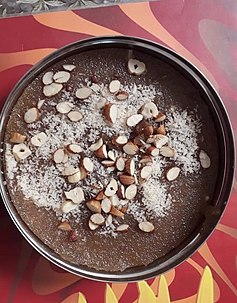 | |
| Alternative names | Rawa sheera, sooji halwa, Mohanbhog, Parsad, Kesari Bat, Rava Kesari |
|---|---|
| Type | Dessert |
| Region or state | India, Pakistan, Bangladesh, Middle East |
| Main ingredients | semolina, sweetener, fat (butter, ghee or oil), milk (optional), fruits and nuts (optional) |
| Similar dishes | Sanwin makin |
Suji ka Halwa (Hindi: सूजी का हलवा, Marathi: रव्याचा शिरा, Urdu: سوجی کا حلوہ) or Mohan Bhog (Hindi: मोहन भोग, Sanskrit: मोहन भोग) is a type of halvah made by toasting semolina (called suji, sooji, or rawa) in a fat like ghee or oil, and adding a sweetener like sugar syrup, honey, or jaggery powder. It can be served for breakfast or as a dessert item. The basic recipe is made with just semolina, sugar or honey, ghee, and sometimes milk. Variations on this include dried or fresh fruits, nuts, shredded coconut, and other toppings. Wheat flour is often used as a substitute if semolina is not available, but virtually any starch can be used to make Suji ka Halwa.
History
In Medieval Arabic cuisine, semolina halvah was made by roasting the milled wheat in butter and adding honey or sugar syrup to moisten the dessert. One recipe for hulwa a'jamiyya is made by boiling honey to create the syrup (diluted with water if needed) and garnished with pistachio and poppyseed. Milk can be added, as well as toppings like almonds, pistachios and pine nuts. Ibn Sayyar al-Warraq's 10th-century cookbook includes varieties made with carrots, apples and dates. Earlier according to some scholars, this dish was introduced to India by the Mughals, but the theory was discredited as it was already listed as shali-anna, present-day Kesari bat, in Manasollasa, a 12th-century work by a South Indian Chalukyan king, Someshvara III.
In 14th-century Spain, semolina was cooked with almond milk, oil and optionally saffron for coloring. In India, suji ka halwa is made from semolina, ghee, and sugar; cardamom and milk, almonds and cashew nuts are added.

Terminology
In Marathi, the halwa made with semolina is called rawa sheera (रवा शीरा). When a similar halwa is prepared with wheat flour it's called gavhacya pithacha sheera (गव्हाच्या पीठाचा शीरा).
In Hindi, it is sooji ka halwa (सूजी का हलवा).
In South India, the dish is currently called Kesari Bat. It is called Sajjige in parts of Tulunadu.
In Myanmar (Burma), the dish is called sanwin makin.
In Mongolia, the dish is called haalmag (lit. "melted")
In the Caribbean, it is known by Indo-Caribbeans as Mohan bhog or simply just as parsad, as it is a common sweet that Hindu Indo-Caribbeans charhaway or offer as prasad in pujas.
See also
References
- Goldstein, Darra (2015). The Oxford Companion to Sugar and Sweets. Oxford University Press.
- Rondinson, Maxime; et al. (1998). Medieval Arab Cookery, essays and translations. Prospect Books. pp. 423–424. ASIN 0907325912.
- Krondl, Michael (2011). Sweet Invention: A History of Dessert. p. 98. ISBN 9781569769546.
- "Full text of "Indian Food Tradition A Historical Companion Achaya K. T."". archive.org. Retrieved 2019-01-30.
- Santanach, Joan (2008). The Book of Sent Sovi: Medieval recipes from Catalonia. Tamesis Books. ISBN 978-1855661646.
- "गव्हाच्या पीठाचा शीरा". Maharashtra Times.
| Cuisine of India | |||||||||||
|---|---|---|---|---|---|---|---|---|---|---|---|
| Regional cuisines |
| ||||||||||
| Ingredients / types of food | |||||||||||
| Preparation and cooking |
| ||||||||||
| Related cuisines | |||||||||||
|
| |||||||||||